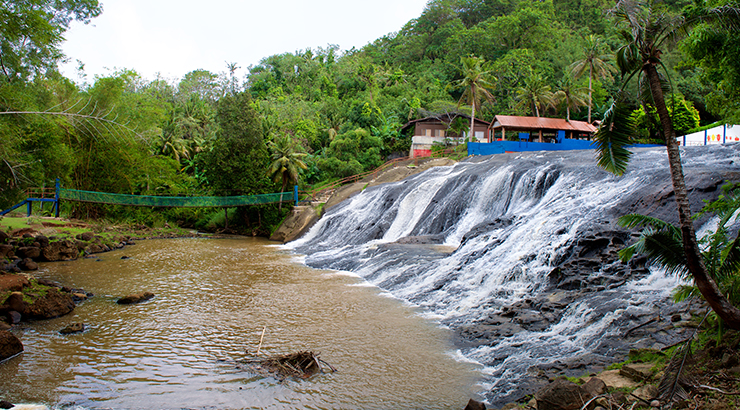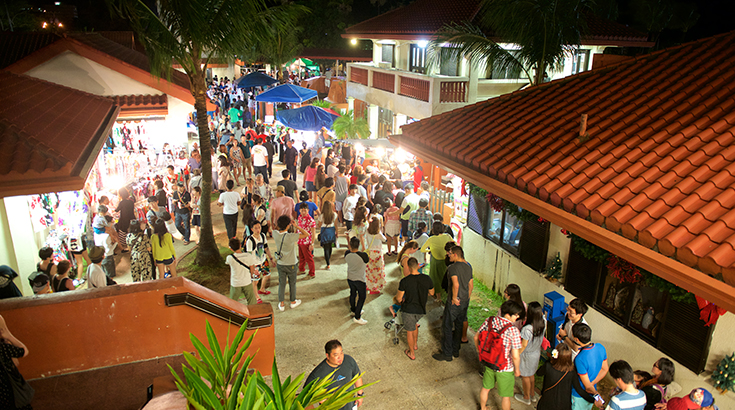

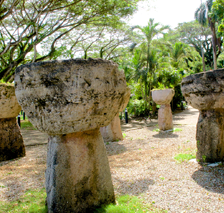
Latte Stone Park
Latte Stones are pillars on which ancient Chamorro houses were constructed as early as 500 A.D. Found nowhere else in the world, Latte Stones have become a signature of Guam and the Northern Marianas Islands. Original Latte Stones were comprised of two pieces, a supporting column (halagi), made from coral limestone, and topped with a capstone (tasa), made from coral heads which were usually carried several miles from the quarry site or reef to the house. Customarily, bones of the ancient Chamorro's and their possessions, such as jewelry or canoes were buried below the stones. Latte Stones are respected and are untouched. Human interlopers at Latte sites may encounter Taotaomoa, or ancestral Chamorro spirits. Today, many Latte sites can be found in Northern Guam . Replicas and images of Latte Stones can also be seen all around the Marianas. Shown here are eight Latte Stones located in Latte Stone Park in central Hagatna where they were transferred from their original location in Me'pu in Guam 's Southern interior.
Latte Stone Park
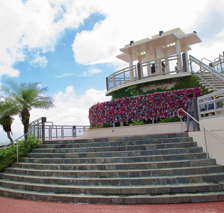
Two Lovers Point
Two Lovers Point. During the time of the Spanish rule, two star crossed lovers plunged to their deaths at this site rather than being separated. As the legend (Puntan Dos Amantes) goes, the daughter of a wealthy Spanish aristocrat and Chamorro, herself the daughter of great chief, was promised, against her will, to a Spanish Captain. The disillusioned daughter, walking along the beach to calm her feelings, met and fell in love with a young Chamorro man. When the father Two Lovers Clifffound out about the young Chamorro and demanded that the daughter marry the Captain, she fled and met her lover near the cliff where they first met. Discovering that his daughter was gone, the father told the Captain that she had been kidnapped and Spanish soldiers were sent to bring her and the man back. Trapped on the point, the two lovers tied their hair together and plunged to their deaths rather than being separated. On this site today sits Two Lovers Point Park with an observation platform jutting out over the cliff that provides breathtaking views of the cliff and rocks below as well as Tumon Bay.
Two Lovers Point
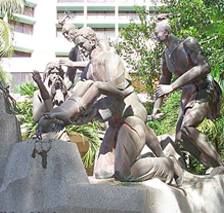
Padre Diego Luis de San Vitores
Padre Diego Luis de San Vitores led the Jesuit missionaries who arrived on Guam in 1668. In 1672, Padre San Vitores and his Filipino assistant were killed by Chief Mata'pang of Tumon for baptizing the Chief's baby girl at the mother's request, but without the Chief's Padre Diego Luis de San Vitores SHrineconsent. The death of Padre San Vitores lead to all-out war that nearly resulted in extinction of the Chamorro race. The Catholic Church however continued to exert considerable influence over the people of Guam. Padre San Vitores Road in Tumon bears his name. A shrine and statue of Padre San Vitores baptizing the Chief's daughter, with the mother and sword wielding Chief standing over them, stands at the location of the slaying between the Guam Reef Hotel and Sails restaurant. The Statue of Padre San Vitores, above left, stands in the courtyard of the Tumon Catholic Church on San Vitores Road.
Padre Diego Luis
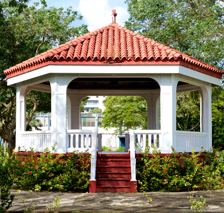
Plaza de Espana
The Plaza de Espana, located in central Hagatna, was the location of the Governors Palace during the Spanish occupation. Most of the palace was destroyed during the shelling of Hagatna during the retaking of Guam in World War II. There are three structures still standing including the three-arch gate to Almacen (Arsena), the Azotea or back porch, and the Chocolate House.
Plaza de Espana
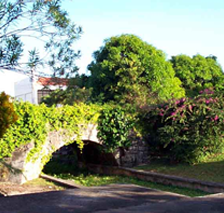
San Antonio Bridge
The San Antonio Bridge (To'lai Acho or stone bridge) was constructed by the Spanish in the 1800's to span the Hagatna River. The original bridge survived the shelling of Hagatna in World War II and continued in use after the War. During the rehabilitation of Hagatna that began in 1945, the river was filled but the bridge was spared and today stands in a small park located across Marine Corps Drive from the Hagatna Marina. On the Northern side of the bridge, you will see "Sirena the Mermaid", a Legends of Guam culture.
San Antonio Bridge
Tailafak Bridge

Dulce Nombre de Maria Cathedral-Basilica
The first Catholic Church on Guam, the Dulce Nombre de Maria {Sweet Name of Mary} Cathedral Basilica was constructed in central Hagatna in 1669. The original church was constructed in 1669-1670 by Chamorro's under the direction of Padre Diego Luis de San Vitores on lands granted by Chief Quipuha, the ranking male of Hagatna at that time. This structure survived until World War II when it was destroyed during the shelling of Hagatna in preparation for the American invasion. The present church was constructed on the original site in 1955-1959.
Dulce Nombre de Maria
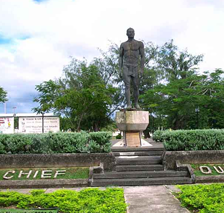
Chief Quipuha Park
Quipuha was the Chief of Hagatna when the Jesuits led by Padre Diego Luis de San Vitores arrived in 1668. Chief Quipuha accepted the Catholic religion and was the first Chamorro Chief to permit himself to be baptized. As Chief, or high-ranking male in the Chamorro matriarchal society of the time, Quipuha had the authority to hand down decisions with the advice and consent of the highest ranking woman in his clan. He granted the land on which the first Catholic Church in Guam was constructed. His statue today stands in Chief Quipuha Park in the center of the Hagatna traffic circle on Marine Corps Drive.
Chief Quipuha Park
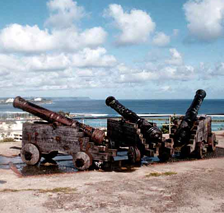
Fort Santa Agueda
Constructed in 1800, Fort Santa Agueda occupied a commanding position overlooking Hagatna Bay and the city of Hagatna. The cannon of Fort Agueda served to protect Hagatna harbor and the lucrative Galleon trade until the Spanish American War when in 1898 when an American frigate entered Hagatna harbor with guns blazing. Hagatna was surrendered the next day. Today the old Spanish cannon still point out over Hagatna Bay from the remnants of Fort Santo Agueda located in Hagatna Heights adjacent to the Governor's residence.
Fort Santa Agueda
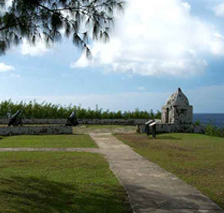
Fort Nuestra Senora de la Soledad
Fort Nuestra Senora de la Soledad was one of the last Spanish Forts constructed in the 19th Century in support of the Spanish Galleon trade. Sitting on the cliff just to the South of Umatac, Fort Soledad has a commanding view of the Bay and all Ocean approaches. The Fort was restored in 1995 and today the cannon of Fort Soledad still point out over the Pacific Ocean and Umatac Bay where Magellan landed in 1521 to make the first contact between Guam and the West.
Fort Nuestra Senora
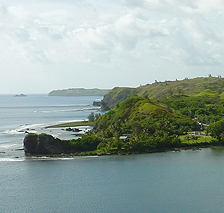
Fort Santo Angel
ort Santo Angel was one of four Spanish forts in the Umatic area and the oldest still in existence. Perched on a rock on the Northwest tip of Umatic Bay, Fort Santo Angel served more as a watchtower than an armed fortification. Today only some of the walls remain. A third and smaller lookout, San Jose, was constructed closer to the water's edge on the Northern tip of Umatac as Fort Santo Angel started to deteriorate near the end of the Galleon era. By the 1850's, both forts were in ruins.
Fort Santo Angel
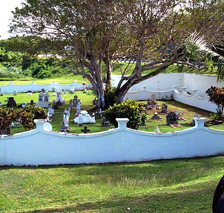
Sumay Cemetery
Sumay was once a prosperous port and thriving seaside community frequented by Spanish, French, German, Japanese, English, Russian and American ships. When Japanese warplanes bombarded Guam in December 1941, Sumay was the first village attacked. The villagers fled into the nearby jungles and were never allowed to return. The village was virtually destroyed. The American military seized Sumay as part of the Naval Station which it remains today. All that remains of the original village is the Spanish occupation era cemetery. Headstones contain epitaphs in both Chamorro and Spanish. The oldest marker claims the year if birth at 1812 and year of death in the 1890's.
Sumay Cemetery
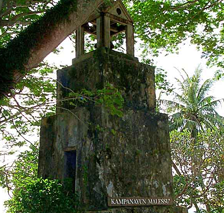
Merizo Bell Tower
The Merizo Bell tower (Kampanayum Malesso) was constructed in 1910 under the direction of Father Cristobal de Canalas to help raise the standard of living for the people of Merizo village. The tower was constructed with stone and cement and the bell was used to announce religious events, town meetings and mass. Although no longer in use today, it has been maintained and is a well known landmark to visit when in the Southern part of the Island.
The Merizo Bell tower
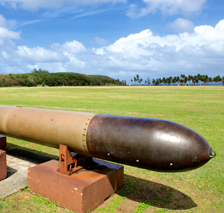
War in the Pacific National Historic Park
The War in the Pacific National Historical Park-Guam was established on August 18, 1978 to commemorate the bravery and sacrifice of those participating in the campaigns of the Pacific Theater of World War II and to conserve and interpret outstanding natural, scenic, and historic values and objects on the island of Guam. Asan Beach, pictured here, is one of 6 units of the Park and War in the Pacific National Historic Park, Asan, Guamwas was one of the main landing areas of the American invasion to recapture Guam from the Japanese in 1944. Other units are Asan Village, Piti, Mount Chacho , Alifan, and Gann Point in Agat. Visitors can still see Japanese costal guns, pillboxes, caves and other relics. Asan Overlook on Nimitz Hill , left, offers breathtaking views of the Bay and landing area. The War in the Pacific National Historic Park visitor center and museum is currently located just north of Asan Beach Park, but is scheduled to be relocated to Asan Overlook in the next few years.
Pacific National Historic Park
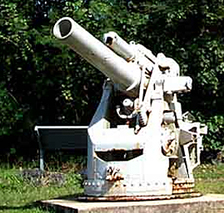
Japanese World War II Landmarks
A number of World II Japanese gun emplacements, caves, foxholes and pillboxes as well as sunken ships and airplanes (Japanese and American) still abound around Guam and under Guam 's clear waters. Japanese costal guns in the village of Piti, Gann Point in Agat and Gun Beach in Tumon are accessible by foot. The camouflaged gun emplacements at Gann Point are connected by a network of tunnels were virtually impregnable by the sea, but were eventually knocked out by American tanks approaching from the rear. The Japanese also constructed an Captured Japanese WWI mini-submarine on Guamextensive system of tunnels in Japanese Caves at LAtte Stone PArk in Aganathe Hagatna area using forced Chamorro, Okinawan and Korean labor. Entrances to the caves, such as the one in Latte Stone Park in Hagatna, can still be seen around the island. Sunken ships and airplanes are accessible to scuba divers and snorkelers. A captured Japanese WWI min-submarine that was sunk outside of Apra Harbor was raised and is on display at the Navy Museum at Sumay Cove.
Japanese World War II Landmarks
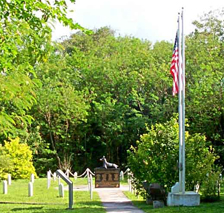
War Dog Memorial
The War Dog Memorial, " Always Faithful.", located on the Naval Facility adjacent to Sumay, honors the Dobermans that served with the Marines in 1944 courageously and valiantly performing duties such as leading scouting parties, exploring caves and serving as sentries. Twenty-five dogs were killed in action and buried, on Guam. For more information check Louise Neumann's War Dog Memorial WEB site or "Always Faithful, A Memoir of the Marine Dogs of WW II", by William W. Putney.
War Dog Memorial
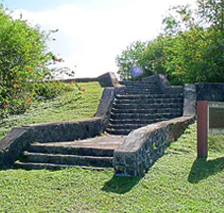
Japanese POW Steps
The War Dog Memorial, " Always Faithful.", located on the Naval Facility adjacent to Sumay, honors the Dobermans that served with the Marines in 1944 courageously and valiantly performing duties such as leading scouting parties, exploring caves and serving as sentries. Twenty-five dogs were killed in action and buried, on Guam. For more information check Louise Neumann's War Dog Memorial WEB site or "Always Faithful, A Memoir of the Marine Dogs of WW II", by William W. Putney.
Japanese POW Steps
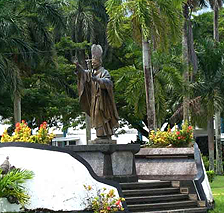
Santo Papa as Juan Pablo Dos Monument
This bronze statue of Pope John Paul II was erected in central Hagatna in commemoration of his 1981 visit to Guam, the first papal visit to Guam since Christianity was introduced by the Jesuits in the 17th century. Located in the middle of Chalan Santo Papa Juan Pablo Dos Street, named in his honor, between Plaza de Espana and Skinner Plaza, the statue stands on the site where John Paul held mass in February 1981 and rotates one full revolution every 12 hours.
Santo Papa
Statue of Liberty
